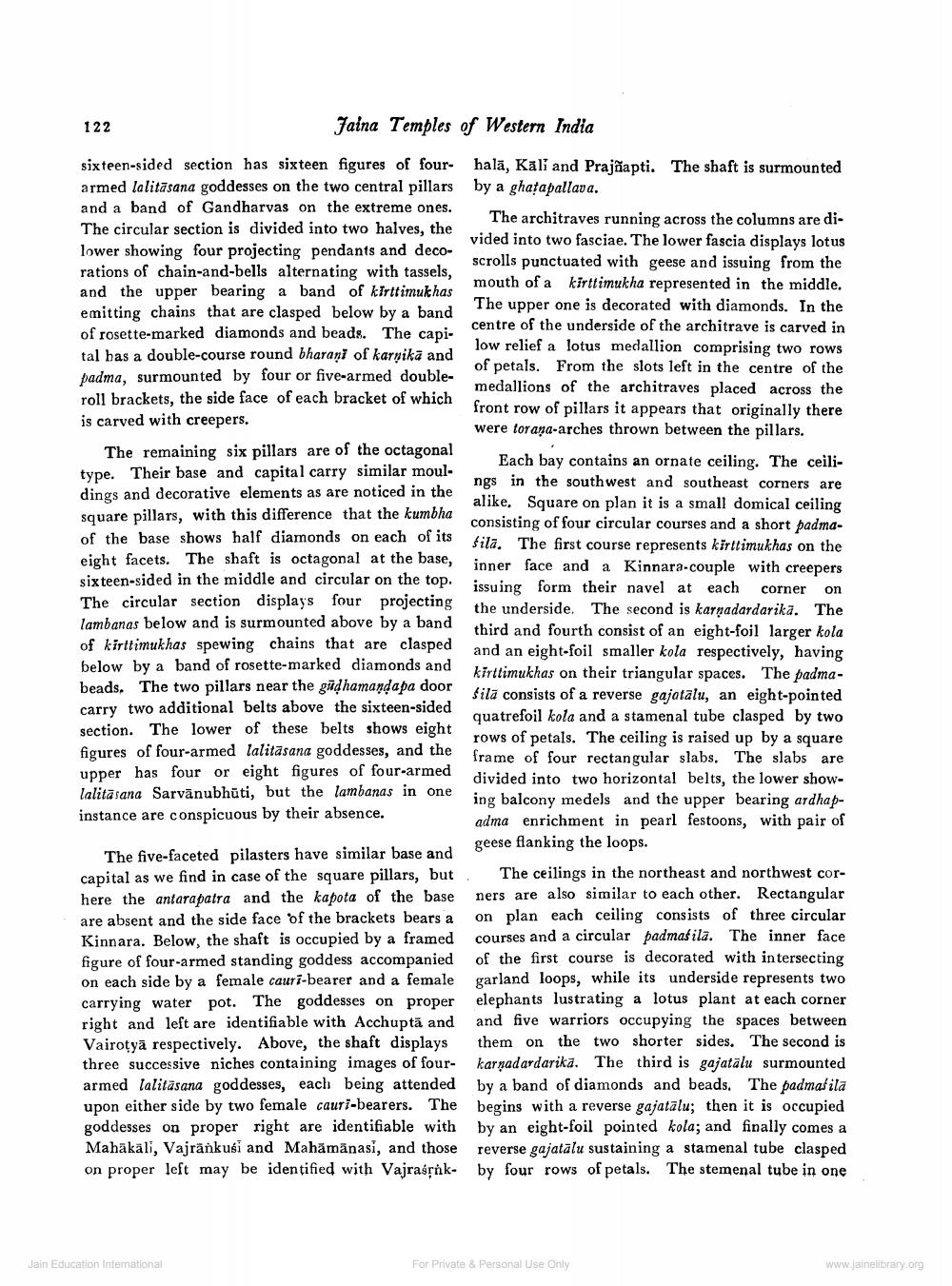________________
122
Faina Temples of Western India
sixteen-sided section has sixteen figures of four- hala, Kali and Prajñapti. The shaft is surmounted armed lalita sana goddesses on the two central pillars by a ghatapallava. and a band of Gandharvas on the extreme ones.
The architraves running across the columns are diThe circular section is divided into two halves, the
vided into two fasciae. The lower fascia displays lotus lower showing four projecting pendants and deco
scrolls punctuated with geese and issuing from the rations of chain-and-bells alternating with tassels, and the upper bearing a band of kirttimukhas
mouth of a kirttimukha represented in the middle. emitting chains that are clasped below by a band
The upper one is decorated with diamonds. In the of rosette-marked diamonds and beads. The capi
centre of the underside of the architrave is carved in
low relief a lotus medallion comprising two rows tal has a double-course round bharani of karnikā and
of petals. From the slots left in the centre of the padma, surmounted by four or five-armed double
medallions of the architraves placed across the roll brackets, the side face of each bracket of which
front row of pillars it appears that originally there is carved with creepers.
were toraņa-arches thrown between the pillars. The remaining six pillars are of the octagonal
Each bay contains an ornate ceiling. The ceilitype. Their base and capital carry similar moul
ngs in the south west and southeast corners are dings and decorative elements as are noticed in the
alike. Square on plan it is a small domical ceiling square pillars, with this difference that the kumbha
consisting of four circular courses and a short padmaof the base shows half diamonds on each of its
fila. The first course represents kirttimukhas on the eight facets. The shaft is octagonal at the base, inner face and a Kinnara-couple with creepers sixteen-sided in the middle and circular on the top.
issuing form their navel at each corner on The circular section displays four projecting
the underside. The second is karņadardarika. The lambanas below and is surmounted above by a band
third and fourth consist of an eight-foil larger kola of kirttimukhas spewing chains that are clasped
and an eight-foil smaller kola respectively, having below by a band of rosette-marked diamonds and
kirttimukhas on their triangular spaces. The padmabeads. The two pillars near the gūdhamandapa door
Sila consists of a reverse gajatalu, an eight-pointed carry two additional belts above the sixteen-sided
quatrefoil kola and a stamenal tube clasped by two section. The lower of these belts shows eight
rows of petals. The ceiling is raised up by a square figures of four-armed lalitasana goddesses, and the
frame of four rectangular slabs. The slabs are upper has four or eight figures of four-armed
divided into two horizontal belts, the lower showlalita sana Sarvānubhūti, but the lambanas in one
ing balcony medels and the upper bearing ardhapinstance are conspicuous by their absence.
adma enrichment in pearl festoons, with pair of
geese flanking the loops. The five-faceted pilasters have similar base and 6 capital as we find in case of the square pillars, but the ceilings in the northeast and northwest corhere the antarapatra and the kapota of the base ners are also similar to each other. Rectangular are absent and the side face of the brackets bears a on plan each ceiling consists of three circular Kinnara. Below, the shaft is occupied by a framed courses and a circular padmašila. The inner face figure of four-armed standing goddess accompanied of the first course is decorated with intersecting on each side by a female cauri-bearer and a female garland loops, while its underside represents two carrying water pot. The goddesses on proper elephants lustrating a lotus plant at each corner right and left are identifiable with Acchupta and and five warriors occupying the spaces between Vairotyā respectively. Above, the shaft displays them on the two shorter sides. The second is three successive niches containing images of four- karnadardarikā. The third is gajatālu surmounted armed talitasana goddesses, each being attended by a band of diamonds and beads. The padmašila upon either side by two female cauri-bearers. The begins with a reverse gajatalu; then it is occupied goddesses on proper right are identifiable with by an eight-foil pointed kola; and finally comes a Mahäkāli, Vajränkusi and Mahămānasi, and those reverse gajatālu sustaining a stamenal tube clasped on proper left may be identified with Vajraspnk- by four rows of petals. The stemenal tube in one
Jain Education International
For Private & Personal use only
www.jainelibrary.org




